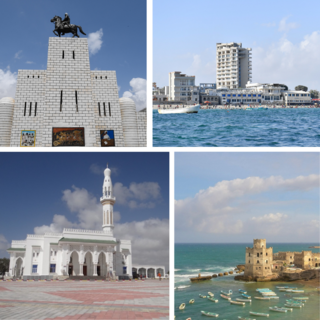Related Research Articles

The Ajuran is a Somali clan, part of the Jambelle clan which itself belongs to the largest Somali clan-family — the Hawiye. Ajuran members largely inhabit Kenya as well as southern east Ethiopia; considerable numbers are also found in southern Somalia. Some Ajuran members are settled in Mogadishu.

Merca is the capital city of the Lower Shebelle province of Somalia, a historic port city in the region. It is located approximately 109 km (68 mi) to the southwest of the nation's capital Mogadishu. Merca is the traditional home territory of the Bimal clan and was the center of the Bimal revolt.

The Hawiye are one of the principal and largest of the Somali clans, tracing their lineage back to Sheikh Ahmed Bin Abdulrahman Bin Uthman, also known as Sheikh Hawiye, the eponymous figure of the clan. They are considered the earliest documented clan to have settled in the Somali peninsula, as noted in the 12th century by Al-Idrisi, occupying the regions spanning from Ras Hafun to Merca, which served as their capital. Presently, the Hawiye reside in central and southern Somalia, Somaliland, Djibouti, the Somali region of Ethiopia, Harar, Oromia, and Afar regions, as well as Kenya. Furthermore, they represent the majority of the population in the capital city of Mogadishu.
Hobyo, is an ancient port city in Galmudug state in the north-central Mudug region of Somalia.

The Rahanweyn, also known as the Digil and Mirifle is a major Somali clan. It is one of the major Somali clans in the Horn of Africa, with a large territory in the densely populated fertile valleys of the Jubba and Shebelle rivers and the areas inbetween, which are mainly inhabited by settlers from the Digil and Mirifle lineages.

The Abgaal are a Somali sub-clan of the Hawiye and the even larger Samaale clan. This prominent Somali clan, despite being one of the youngest in Somalia, is one of the most significant in the nation's history and has given rise to many notable figures, including three presidents, including the current one as well as the founding father of the Somali military. Their stronghold is the capital city of Somalia, Mogadishu, where they are known to be the earliest inhabitants and they currently constitute the majority of the population there.
Ayr is a Somali clan that is part of the larger Habar Gidir Hawiye clan. The Ayr clan is the eldest Habargidir sub-clan and is the largest Habargidir sub-clan in population. The Ayr clan have a rich history in Somali society and has played an important role in shaping Somali history and national politics. Members of the clan reside in 6 out of the total 18 regions of Somalia but are primarily found in the central region of Somalia - Galgaduud region which they hold a monopoly over and is considered their heartlands. They are considered the most powerful sub-clan in central and southern Somalia controlling important sections of the country and greatly influencing the nation's capital Mogadishu, holding the 1st mayorship position in the post-independence era. The Ayr are regarded as being very large in numbers because they are spread throughout numerous regions in Somalia and are significant to the country's political, economic, social, and military sectors.

The Ajuran Sultanate, natively referred to as Ajuuraan, and often simply Ajuran, was a medieval Muslim Empire in the Horn of Africa. Founded by Somali Sultans it ruled over large parts of the Horn of Africa during the Middle Ages via control over water. Its rise to prominence began during the 13th and 14th century. By the 15th century, the Ajuran were Africa's only 'Hydraulic empire'. Through a strong centralized administration and an aggressive military stance towards invaders, the Ajuran Empire successfully resisted Oromo invasions from the west and fought against Portuguese incursions from the east.

The Murusade, also contemporarily known as Mursal, are a Somali subclan, part of the Karanle branch of the larger Hawiye Clan. They primarily reside in the central regions of Somalia, particularly in the Galgaduud, Lower Shabelle, Middle Shabelle and Banadir regions.
Afgooye is a town in the southeastern Somalia Lower Shebelle region of Somalia. It is the center of the Afgooye District. Afgooye is the third largest city of Southwest State. Afgooye is one of the oldest towns on the lower Shebelle valley, 30 kilometers north of Mogadishu. Afgooye is the site of Lafoole college, the first college of education in Somalia, built on the site of the battle of Lafoole of 1896. Afgooye is also known for the Istunka, the annual "stick fight" carnival commemorating the New Year in the riverine region. It was a trade center for the Silcis Dynasty in the medieval period then fell under Ajuran rule. Around the late 17th century, Afgooye became the capital of Geledi Sultanate.

The Bimaal or Bimal, are a sub-clan of the major Dir clan family. This clan is widely known for leading a resistance against the colonials in southern Somalia for decades which can be compared to the war of the Sayyid in Somaliland. The Biimaal mainly lives in southern Somalia, the Somali region of Ethiopia, which their Gaadsen sub-clan mainly inhabits.
Ibrahim Adeer was a Somali ruler. He founded the Sultanate of the Geledi. He subsequently established the Geledi sultanate's ruling house, the Gobroon dynasty, after having to successfully rebel and expel the Ajuran Sultanate and ruled large parts of Horn of Africa.

The Sultanate of the Geledi also known as the Gobroon dynasty, was a Somali kingdom that ruled parts of the Horn of Africa during the late-17th century to the early 20th century. The Sultanate was governed by the Gobroon dynasty. It was established by the Geledi soldier Ibrahim Adeer, who had defeated various vassals of the Ajuran Sultanate and elevated the Gobroon to wield significant political power. Following Mahamud Ibrahim's consolidation, the dynasty reached its apex under Yusuf Mahamud Ibrahim, who successfully modernized the Geledi economy and eliminated regional threats with the Conquest of Bardera in 1843, and would go on to receive tribute from Said bin Sultan, the ruler of the Omani Empire. Geledi Sultans had strong regional ties and built alliances with the Pate and Witu Sultanates on the Swahili coast. Trade and Geledi power would continue to remain strong until the death of the well known Sultan Ahmed Yusuf in 1878. The sultanate was eventually incorporated into Italian Somaliland in 1911.

The Majeerteen Sultanate, or Majerteen Kingdom also known as Majeerteenia and Migiurtinia, was a Somali kingdom centered in the Horn of Africa. Ruled by Boqor Osman Mahamuud during its golden age, the sultanate controlled the areas which are now called Puntland. The earliest mention of the kingdom is the 16th century. The polity had all of the organs of an integrated modern state and maintained a robust trading network. It also entered into treaties with foreign powers and exerted strong centralized authority on the domestic front.
Ajuran may refer to:

This is a list of Somali aristocratic and court titles that were historically used by the Somali people's various sultanates, kingdoms and empires. Also included are the honorifics reserved for Islamic notables as well as traditional leaders and officials within Somali customary law (xeer), in addition to the nobiliary particles set aside for distinguished individuals.

The Geledi are a Somali clan that live predominantly in the environs of Afgooye city. They are a sub-clan of the Rahanweyn and led the Geledi Sultanate during the late 17th to early 20th century. They are divided into two main lineage groups: the Tolweyne and the Yabadhaale.
The Tunni are a Somali clan that make up part of the wider Digil-Rahanweyn branch. It is one of the major clans that inhabit the South West State of Somalia and can also be found in Jubbaland.
The Tunni Sultanate was a Somali Muslim Sultanate located in southwestern Somalia, south of the Shabelle river. It was ruled by the Tunni people, who speak the Af-Tunni language. The historical Tunni area corresponds to the modern-day Lower Shabelle region.

The Muẓaffarids were a Muslim dynasty that ruled the Banaadir coast with their capital at Mogadishu from the late 15th or early 16th century until around 1624 or possibly as late as 1700. They were of Persian extraction that mixed with the local Somali population and are related to the Ajuran clan. They were effectively independent, but allied to the more powerful Ajuran Sultanate. They resisted the Portuguese, but occasionally paid them tribute. In the 17th century, the Muẓaffarids were conquered by the Somali Abgaal.